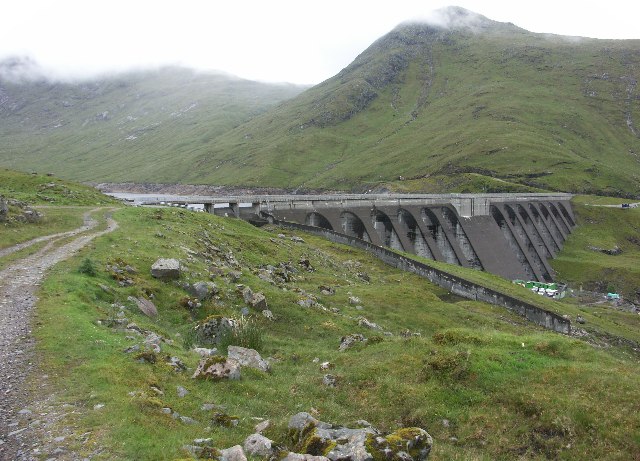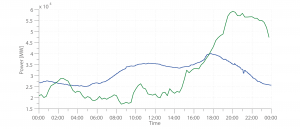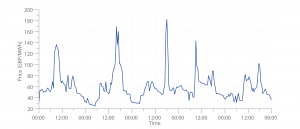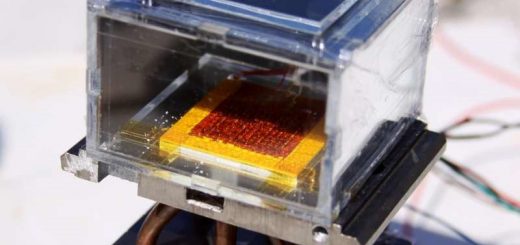The Future of Electricity Supply and Demand: Smart Devices Responding to The Grid’s Health

Increased use of renewable energy sources in the future will bring about challenges in being able to meet electricity demand with sufficient supply. This is because, unlike conventional power plants, renewable electricity sources such as wind turbines and solar panels provide a fluctuating output that is difficult to control and difficult to predict.
Current plans by the Scottish Government involve the country becoming self-sufficient in terms of electricity supply from renewables in the next decade. The ‘2020 Routemap for Renewable Energy’ sets out “to meet an equivalent of 100% demand from renewable energy by 2020” 1. In addition to the Scottish Government’s ambitious target, the UK government is also targeting a reduction in CO2 emissions by 34% compared to 1990 levels by the same year 2. The UK government is also looking to renewable energy sources as a way of being able to turn off the fossil fuel power plants which produce greenhouse gases.
The problem that is increasingly being encountered is that the fluctuations caused by renewable energy sources – such as the fluctuation in output from wind turbines as the wind speed and air density changes throughout the day – have an impact on the stability of the National Grid. The National Grid controllers fight every minute of every day to keep the level of electricity supply matched with the electricity demand at any given time. Every time you turn on the kettle, a power plant somewhere in the country has to slightly increase its output to cope. Conversely, every time you switch off your TV, a power plant has to slightly lower its output. On occasions where the supply-to-demand balance is not maintained perfectly, the frequency of the alternating current supplied by the National Grid to your wall sockets will fluctuate above and below 50 Hz. During times of excess demand, the frequency falls slightly below 50 Hz, and during times of excess supply it rises slightly above it. Ordinarily these changes are small enough not to be a problem, and it is easier for grid controllers to maintain a certain level of electricity supply with the current fleet of fossil fuel power plants. Fossil fuel power plants are in this sense ideal, as they can quickly produce a vast amount of stable electricity output which is useful for keeping the grid in balance. However, if the country is to meet its targets for reducing greenhouse gas emissions and if it is to become an electricity self-sufficient nation, then some of these plants are going to need to be switched off.
If there were enough wind turbines in the UK to generate enough electricity to match the electricity demand, then the output would look something like the green series in this graph:

A hypothetical wind supply (green) and electricity demand (blue) profile across a day. Wind production data from Ireland has been scaled so that the total electricity supply matches the total demand. It is clear to see that throughout the day there are occasions when there is either too much or too little electricity production to meet demand. Unscaled wind production data provided by EirGrid, corresponding to the Republic of Ireland and Northern Ireland wind supply on 23rd October 2011. Demand data provided by National Grid for same date.
The blue series shows the electricity demand profile for the same day. Despite the wind turbines on this day producing one joule of electricity for every one joule of electricity consumed, production and supply are out of sync, and so there are occasions where there is an electricity deficit or surplus.
At present, any excess electricity production from wind turbines is lost. In this event, National Grid controllers would be forced to switch off supply from some renewable energy sources to avoid the AC frequency rising beyond legal limits. What if we could store that excess energy? This is where ‘dynamic demand control’ becomes useful. Dynamic demand control is a concept whereby the electricity consumption of a series of devices is managed in a way that it responds to the state, or ‘health’, of the grid. It can sense the frequency of the grid and from that infer the level to which supply and demand are matched, and take action accordingly. If there were to be a spike in supply, such as after EastEnders (when, famously, the Great British public add up to 1 GW, equivalent to two Cruachan Dams, of extra load to the grid as they simultaneously turn on their kettles), the device could then ramp down its electricity usage temporarily until the spike has passed, before increasing its demand to compensate later. This would then help to smooth out fluctuations in the supply-demand curve, resulting in less wasted renewable energy. If the nature of the device is such that it does not require a constant source of electricity, then it can take part in dynamic demand control.
The concept has previously been demonstrated in fridges and cars, but recent work in the University of Glasgow has shown that the concept is also suitable for laptops 3. The high number of laptops and consumer electronics devices with built-in batteries in use at any given time can have a significant positive impact on the stability of the grid. Collectively, the millions of laptops in use at any given time can provide mitigation of the order equivalent to a large power plant coming online.
The system developed by the scientists in the School of Physics and Astronomy at the university involves two different approaches: a hardware device which sits in between the laptop’s charger and the wall socket, controlling the electricity flow to the laptop; and a software approach, obtaining information about the grid frequency using the World Wide Web and controlling the battery’s charging in this manner. The former approach allows for current laptops to be retrofitted with a device which can regulate the charging of any laptop, and the same device is not necessarily restricted to laptops but to any device with a suitable form of buffer such as a battery (the insulated thermal mass in a fridge is another example). The latter approach requires a laptop to be manufactured with suitable hardware which the device’s software can interface with. During the course of the study, the researchers only found a few models from only one brand suitable for this software technique, so this technique would primarily apply to future hardware.
Despite the pitfalls, the advantage of a software solution is clear: no changes to the device’s hardware are required except for a suitable battery management software interface, which is often just a case of having the manufacturer make available the necessary drivers. Additionally, the software could be user configurable so that smart charging is not performed during unwanted hours. For example, a user with a presentation to give at 9am the following morning may wish to make sure that their laptop’s battery has at least 80% charge as of 8am, regardless of the health of the grid. The software could then assist the grid as required except in the case where it would interfere with the user’s own requirements.
But what incentive does the laptop owner have to use such a system? The laptop is being used by the National Grid to store power with seemingly nothing being given to the laptop owner in return. To solve this dilemma, it is necessary to consider how the wholesale electricity market in the UK operates. The utility companies that supply electricity to our homes tender for electricity on a market under the administration of the National Grid PLC. Each utility company does not need to produce its own customer’s electricity, rather it may purchase supply from other providers or sell its own excess. The price of a unit of electricity is set by the economics of supply and demand, meaning that during times of excess electricity demand surplus or supply deficit the prices will increase, and vice versa. The difference that utility companies can pay between peak and off-peak times can be as much as 500%. Although this sounds dramatic, in reality it only results in a small cost saving for the electricity companies. Reduced tariffs for users of dynamic demand devices are unlikely to be worthwhile. Therefore, an incentive to end users could come in the form of a monthly prize draw, though realistically it might rely on government legislation or the ‘goodwill’ feeling of a user being ‘green’ to make sure these devices become widely used.

Wholesale electricity prices available to utility companies during a week in November 2012. The price companies pay can vary by as much as 500%. Data taken from bmreports.com.
Would a smart charger have a negative effect on the laptop’s battery? Surprisingly, this might not be the case. Some laptops charge their battery even when plugged in (‘trickle charging’), and large, quick charges can cause excess heat, which is a big battery life killer 4. Using a smart charging system can result in slower, shallower charges and discharges, keeping the temperature down, and less time spent trickle charging, which can allow the battery to maintain its longevity. Frequent, small discharges also allow the laptop’s operating system to obtain a more accurate reading of its estimated battery life.
With demand on the increase and the burning of fossil fuels becoming less attractive, the electricity grid of the future will have to be highly adaptive to the natural conditions affecting renewable energy production. With techniques such as dynamic demand control, perhaps in the form of smart laptop chargers, the grid can safely integrate more renewable energy sources, bringing about a sustainable energy future.
References
- Read the plan here.
- Climate Change Act, 2008
- Read paper here.
- Bloom, B.W Cole, J.J Sohn, S.A Jones, E.G Polzin, V.S Battaglia, G.L Henriksen, C Motloch, R Richardson, T Unkelhaeuser, D Ingersoll, H.L Case. An accelerated calendar and cycle life study of Li-ion cells. Journal of Power Sources. 2001











In order to retain your gaming beneath manage, attempt to strategy out gaming sessions with definitive limits.
But in SMS marketing, Information goes fasater to mobiles and also the customer reads it without
delay. As clients migrate too more cnvenient banking processes thhe number of potential targets
for phishers grows each week. The thing to keep
in mind is always that all routers vary so make sure yyou read any documentation sent with the device.